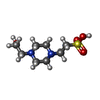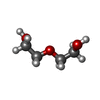+ Open data
Open data
- Basic information
Basic information
| Entry | Database: PDB / ID: 6ltz | ||||||
|---|---|---|---|---|---|---|---|
| Title | Induced DNA bending by unique dimerization of HigA antitoxin | ||||||
 Components Components | Putative antitoxin HigA3 | ||||||
 Keywords Keywords | ANTITOXIN | ||||||
| Function / homology | Helix-turn-helix / Helix-turn-helix XRE-family like proteins / Cro/C1-type HTH domain profile. / Cro/C1-type helix-turn-helix domain / Lambda repressor-like, DNA-binding domain superfamily / DNA binding / DI(HYDROXYETHYL)ETHER / Putative antitoxin HigA3 Function and homology information Function and homology information | ||||||
| Biological species |  Mycobacterium tuberculosis H37Rv (bacteria) Mycobacterium tuberculosis H37Rv (bacteria) | ||||||
| Method |  X-RAY DIFFRACTION / X-RAY DIFFRACTION /  SYNCHROTRON / SYNCHROTRON /  SAD / Resolution: 1.973 Å SAD / Resolution: 1.973 Å | ||||||
 Authors Authors | Park, J.Y. / Lee, B.J. | ||||||
| Funding support |  Korea, Republic Of, 1items Korea, Republic Of, 1items
| ||||||
 Citation Citation |  Journal: Iucrj / Year: 2020 Journal: Iucrj / Year: 2020Title: Induced DNA bending by unique dimerization of HigA antitoxin. Authors: Park, J.Y. / Kim, H.J. / Pathak, C. / Yoon, H.J. / Kim, D.H. / Park, S.J. / Lee, B.J. | ||||||
| History |
|
- Structure visualization
Structure visualization
| Structure viewer | Molecule:  Molmil Molmil Jmol/JSmol Jmol/JSmol |
|---|
- Downloads & links
Downloads & links
- Download
Download
| PDBx/mmCIF format |  6ltz.cif.gz 6ltz.cif.gz | 46.5 KB | Display |  PDBx/mmCIF format PDBx/mmCIF format |
|---|---|---|---|---|
| PDB format |  pdb6ltz.ent.gz pdb6ltz.ent.gz | 30.9 KB | Display |  PDB format PDB format |
| PDBx/mmJSON format |  6ltz.json.gz 6ltz.json.gz | Tree view |  PDBx/mmJSON format PDBx/mmJSON format | |
| Others |  Other downloads Other downloads |
-Validation report
| Summary document |  6ltz_validation.pdf.gz 6ltz_validation.pdf.gz | 472.8 KB | Display |  wwPDB validaton report wwPDB validaton report |
|---|---|---|---|---|
| Full document |  6ltz_full_validation.pdf.gz 6ltz_full_validation.pdf.gz | 476.7 KB | Display | |
| Data in XML |  6ltz_validation.xml.gz 6ltz_validation.xml.gz | 10.1 KB | Display | |
| Data in CIF |  6ltz_validation.cif.gz 6ltz_validation.cif.gz | 12.9 KB | Display | |
| Arichive directory |  https://data.pdbj.org/pub/pdb/validation_reports/lt/6ltz https://data.pdbj.org/pub/pdb/validation_reports/lt/6ltz ftp://data.pdbj.org/pub/pdb/validation_reports/lt/6ltz ftp://data.pdbj.org/pub/pdb/validation_reports/lt/6ltz | HTTPS FTP |
-Related structure data
- Links
Links
- Assembly
Assembly
| Deposited unit | 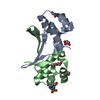
| ||||||||
|---|---|---|---|---|---|---|---|---|---|
| 1 |
| ||||||||
| Unit cell |
|
- Components
Components
| #1: Protein | Mass: 12891.620 Da / Num. of mol.: 2 Source method: isolated from a genetically manipulated source Source: (gene. exp.)  Mycobacterium tuberculosis H37Rv (bacteria) Mycobacterium tuberculosis H37Rv (bacteria)Strain: H37Rv / Gene: higA3, Rv3183 / Production host:  #2: Chemical | #3: Chemical | ChemComp-EPE / | #4: Chemical | #5: Water | ChemComp-HOH / | Has ligand of interest | N | |
|---|
-Experimental details
-Experiment
| Experiment | Method:  X-RAY DIFFRACTION / Number of used crystals: 1 X-RAY DIFFRACTION / Number of used crystals: 1 |
|---|
- Sample preparation
Sample preparation
| Crystal | Density Matthews: 2.2 Å3/Da / Density % sol: 44.21 % |
|---|---|
| Crystal grow | Temperature: 293 K / Method: vapor diffusion, sitting drop Details: 1 M ammonium sulfate, 0.1 M HEPES, 0.5% w/v PEG8000 |
-Data collection
| Diffraction | Mean temperature: 100 K / Serial crystal experiment: N |
|---|---|
| Diffraction source | Source:  SYNCHROTRON / Site: PAL/PLS SYNCHROTRON / Site: PAL/PLS  / Beamline: 5C (4A) / Wavelength: 0.9794 Å / Beamline: 5C (4A) / Wavelength: 0.9794 Å |
| Detector | Type: ADSC QUANTUM 315r / Detector: CCD / Date: Jul 12, 2016 |
| Radiation | Protocol: SINGLE WAVELENGTH / Monochromatic (M) / Laue (L): M / Scattering type: x-ray |
| Radiation wavelength | Wavelength: 0.9794 Å / Relative weight: 1 |
| Reflection | Resolution: 1.97→50 Å / Num. obs: 15201 / % possible obs: 100 % / Redundancy: 3.5 % / Rrim(I) all: 0.06 / Net I/σ(I): 41.5 |
| Reflection shell | Resolution: 1.97→2 Å / Num. unique obs: 762 / CC1/2: 0.978 / Rrim(I) all: 0.194 |
- Processing
Processing
| Software |
| ||||||||||||||||||||||||||||||||||||||||||
|---|---|---|---|---|---|---|---|---|---|---|---|---|---|---|---|---|---|---|---|---|---|---|---|---|---|---|---|---|---|---|---|---|---|---|---|---|---|---|---|---|---|---|---|
| Refinement | Method to determine structure:  SAD / Resolution: 1.973→32.113 Å / SU ML: 0.25 / Cross valid method: THROUGHOUT / σ(F): 1.43 / Phase error: 23.06 SAD / Resolution: 1.973→32.113 Å / SU ML: 0.25 / Cross valid method: THROUGHOUT / σ(F): 1.43 / Phase error: 23.06
| ||||||||||||||||||||||||||||||||||||||||||
| Solvent computation | Shrinkage radii: 0.9 Å / VDW probe radii: 1.11 Å / Solvent model: FLAT BULK SOLVENT MODEL | ||||||||||||||||||||||||||||||||||||||||||
| Displacement parameters | Biso max: 110.71 Å2 / Biso mean: 39.4561 Å2 / Biso min: 16.36 Å2 | ||||||||||||||||||||||||||||||||||||||||||
| Refinement step | Cycle: final / Resolution: 1.973→32.113 Å
| ||||||||||||||||||||||||||||||||||||||||||
| LS refinement shell |
|
 Movie
Movie Controller
Controller




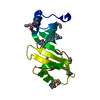
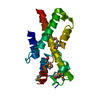
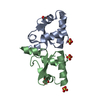




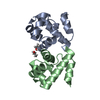
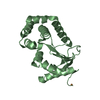

 PDBj
PDBj





